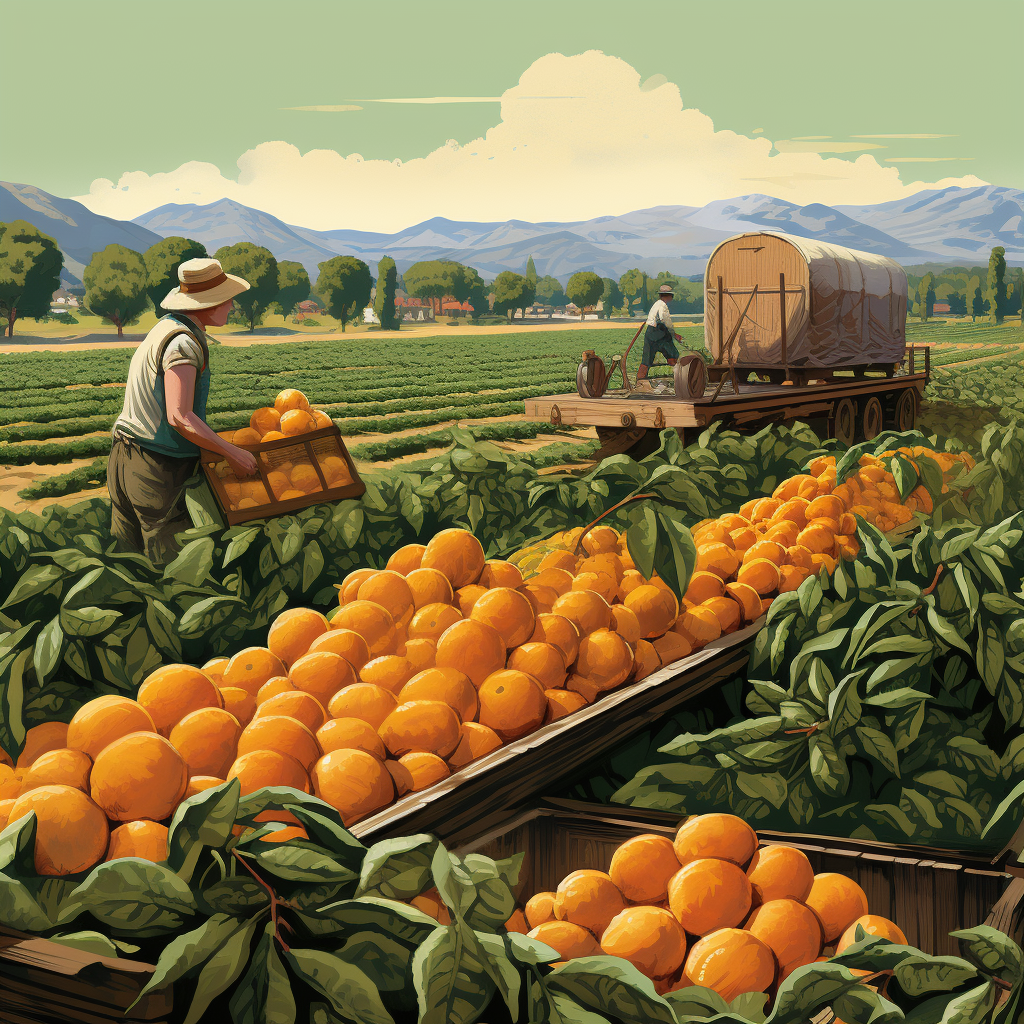Bursting into Color: Origins of the Citrus Industry in San Gabriel Valley
The Dawn of the Citrus Boom
The sun-drenched plains of the San Gabriel Valley were not always synonymous with the vibrant hues of orange, lemon, and lime groves. In the mid-19th century, this area was a mosaic of wheat fields and vineyards, dotting the landscape from Pasadena to Pomona.
However, a whisper promising riches and prosperity started to rustle in the wind, and the name of this whisper was citrus. Thus began the transformation of the San Gabriel Valley into an Eden of countless citrus groves.
The origins of the citrus industry can be traced back to two pioneers who saw potential in the valley’s fertile soil and favorable climate. William Wolfskill, an adventurous Kentuckian, planted the first commercial citrus orchard in Los Angeles in 1841.
Meanwhile, in Riverside, Eliza Tibbets received two navel orange trees from a friend at the Department of Agriculture in Washington, D.C. These trees sparked an agricultural revolution as they bore fruit that was sweet, seedless, and effortlessly caught the public’s affection – a perfect combination for commercial success.

Golden Oranges, Golden Opportunity
With the completion of the transcontinental railroad in 1869, the doors to the east were swung wide open. Thousands flocked to the San Gabriel Valley, drawn by promises of gold. Not gold nuggets from the ground, but golden spheres hanging from the trees. The towns of Pomona, Monrovia, Covina, and Azusa welcomed these newcomers with open arms, their populations ballooning as the citrus boom continued to gain momentum.
The citrus industry did more than just redefine the economic fabric of the San Gabriel Valley; it reshaped the region’s social and cultural landscape. The groves provided employment opportunities to the waves of immigrants arriving from Asia and Mexico, forever intertwining their cultures and traditions with the region’s identity.
Communities sprang up around the citrus groves, cultivating an ambiance of multicultural inclusivity and cooperation that persists in these towns to this day.
The Cultural Imprint of Citrus
The impact of the citrus industry is evident even today, with landmark locations across the San Gabriel Valley testifying to its enduring legacy. The historical Citrus Avenue in Covina, once a bustling route for transporting fresh fruit, is now a charming boulevard boasting antique shops and boutique restaurants.
Meanwhile, the presence of the imposing Packing House in Claremont, a relic from the era of commercial citrus packing, serves as a tangible reminder of the industry’s significance.
In Pasadena, the grand Tournament of Roses Parade was initially an event to celebrate the valley’s endless summer, where fruits ripened while other regions were buried under snow. The spectacle would eventually evolve into an internationally recognized celebration, drawing visitors from around the world to marvel at the magnificent floats adorned with vibrant flowers and, of course, citrus.
Through these landmarks and traditions, the citrus heritage continues to breathe life into the San Gabriel Valley. The story of the citrus industry is not just a tale of a successful agricultural venture, but a testament to the power of community, diversity, and resilience that shaped the identity of the San Gabriel Valley.
Cities of Gold: How Citrus Transformed the Landscape of San Gabriel Valley
A Golden Dawn in San Gabriel Valley
In the late 19th century, the renowned San Gabriel Valley, nestled in Southern California, was experiencing a transformation that would indelibly echo through the pages of history. The sun-drenched expanse was on the cusp of an agricultural revolution, birthing a vibrant era filled with the zesty aroma of citrus blossoms.
Enriching the valley soil were acres upon acres of orange groves, a sight as surreal for the first settlers as it was transformative for the cityscape.
The cities of Pasadena, Pomona, and Covina, previously barren and desolate, were emerging as flourishing epicenters of gold—not the metallic ore mined by 49ers, but golden orbs of citrus. The sun-baked landscapes were transformed into blanketed carpets of emerald leaves and brilliant orange fruits that reflected the sunlight like a mirage of gold coins, justifying their moniker ‘cities of gold’.

Pruning the Path to Prosperity
The economic boom reverberated across the social stratum. The labor-intensive efforts of Chinese immigrants, diligent farmers, and industrious ranch workers propelled these cities towards prosperity.
They became composite characters immortalizing the spirit of the era, labored under a relentless Californian sun, their hands adeptly pruning, picking, and packing the rich bounty of oranges.
Covina, known fondly as ‘Orange Belt’, led the pack with the establishment of orange growers’ associations. Pasadena clung onto its lead through the wealth generated from these citric goldmines, leading to the construction of ornamental gardens and grand mansions such as the historic Gamble House.
Pomona, however, bore the true symbolic testament of the era—the beautifully preserved La Casa Primera, built by the pioneer Francisco Palomares, whose success story pivoted around his established vineyards and citrus orchards.
San Gabriel’s Citrus-Infused Society
As the citrus industry thrived, it not only transformed the economic landscape but left an enduring impact on the cultural and social fabric of San Gabriel Valley. Residents and visitors were drawn to the sun-drenched ‘Orange Empire’, lured by the paradise-like vista of neatly lined rows of citrus groves.
These towns became living portraits of prosperity, their growth infused with the fragrant essence of orange blossoms.
The citrus craze was reflected in local traditions too, such as the iconic Tournament of Roses parade in Pasadena, where floats festooned with citrus fruits and flowers paraded through the city streets every New Year’s Day. The spirit of the era was captured in Pomona’s yearly Los Angeles county fair, which celebrated the city’s rich agricultural heritage.
The citrus legacy of the San Gabriel Valley has endured, sculpting both the landscape and identity of the region. While the groves may have largely disappeared, replaced by urban development, the cities of gold continue to bask in their citric glory, their historical roots buried deep within the scent of the vanishing orange blossoms.
Cultural Melting Pot: Impact of the Citrus Boom on Social Structures
Beginnings of a Citrus Empire
As 1880 dawned, the expansive plains and foothills of the San Gabriel Valley were in the midst of a transformation. The rich soil, ideal for farming, was beginning to yield an abundance of citrus fruit, primarily oranges.
This fascinating citrus boom was not only changing the landscape but instigating a cultural shift, making places like Pasadena, Monrovia, and Azusa romanticized symbols of prosperity.

The San Gabriel Valley was swiftly becoming a bustling nexus of activity as Easterners, seeking better fortunes, streamed in. The valley’s burgeoning citrus industry promised wealth, attracting an eclectic mix of pioneers, including midwestern farmers, Spanish rancheros, Chinese laborers, and African-American settlers.
Their united toiling in the orange groves planted seeds of a diverse society that would come to characterize the area.
Citrus Catalyzing Cultural Change
This amalgamation of cultures presented a unique dynamic that played out vividly against the backdrop of the citrus groves. Soon, familiar melodies from the East intermingled with the soulful strums of Spanish guitars, punctuated by the rhythmic chants of Chinese immigrants.
This fusion reverberated through the valleys, personifying the cultural melting pot that San Gabriel had become.
One could easily spot David C. Cook, a midwestern publisher, trading tales with Eulalia Perez, the diligent keeper of Mission San Gabriel. These interactions mirrored the harmonious coexistence that started taking root in the valley, symbolizing unity in diversity, a theme still celebrated in the region today.
The Economic Ripple Effect
The citrus boom did not just bring cultural changes; it also spurred economic growth, varying social structures, and infrastructural development. Cities like Pomona, Arcadia, and Glendora saw a significant surge in land prices, sparking a real estate boom.
The citrus industry’s profits orchestrated the rise of formidable institutions like the Bank of Pasadena in 1886, built to manage the escalating wealth. Railroad tracks crisscrossed the valley, facilitating the transportation of the golden fruit to faraway lands.
The Southern Pacific Railroad Station, an iconic landmark in Monrovia, became a hub of frenzied activity.
As the citrus groves grew thick and vast, so did the cultural richness and economic prosperity of the San Gabriel Valley. The region transformed from a collection of quaint homesteads to a flourishing melting pot of diverse cultures and socioeconomic statuses, thanks to the sweet allure of citrus.
The evolution marked by the citrus boom continues to resonate through the picturesque boulevards and thriving multicultural communities of San Gabriel Valley, shaping its unique identity today.
From Grove to Market: Understanding the Economic Influence of the Orange Empire
Birth of the California Citrus Empire
As the sun rises over the San Gabriel Valley in the late 19th century, the lingering scent of oranges wafts through the air and paints a picture of a homeland blessed with fertile soil. Rooted in what’s now the cities of Pasadena, Monrovia, and Pomona, the citrus groves stretch as far as the eye can see, transforming the landscape into a vibrant mosaic of green and orange.

This was the dawn of the California Citrus Empire, a significant era ignited by the arrival of Judge Benjamin Eaton and his seedlings of naval oranges in 1873. The strategic placement of these groves along the Southern Pacific Railroad gave rise to an industry that would revolutionise the economy of the San Gabriel Valley and the entirety of California.
The fragrant blossoms came to symbolize prosperity — each tree was a testament to the settlers’ determination and entrepreneurial spirit. Indeed, the bustle of pickers, packers, and shippers at work was a sight to behold, their tireless efforts under the California sun yielding golden fruits that were destined for markets across the country.
The Economic Impact: Fruitful Harvests, Flourishing Cities
The lucrative citrus groves turned the tide for the once modest towns within the San Gabriel Valley. The booming industry attracted entrepreneurs, migrant workers, and railway companies alike, shaping the urban design of these burgeoning cities.
With its expansive groves, lush landscapes, and newfound wealth, the region became a symbol of the California Dream.
Pasadena bore witness to this extraordinary transformation. Aided by the transcontinental railroad, its oranges reached tables on the East Coast, turning the once quiet settlement into a prosperous city.
Monrovia, too, experienced rapid growth, with its Monrovia Nursery Company becoming a leading exporter of citrus trees around the globe. In Pomona, the fruit’s profitability led to mass urbanisation and propelled the city’s rise as a significant economic hub.
From Grove to Greatness: The Social Tapestry of the Citrus Empire
With abundance came challenges and opportunities, giving birth to a diverse social fabric that would shape the region. The citrus industry saw a surge in immigrant labor, including Japanese, Chinese, and Mexican workers – each contributing significantly to the cultural diversity that characterises the San Gabriel Valley today.
The citrus era also championed progress. Pioneering women like Clara Baldwin Stocker embraced the industry, which sparked female entrepreneurship in the region. The prosperity led to philanthropic efforts, the creation of educational institutions, and the inception of elaborate architectural styles depicted in landmark buildings such as the Gamble House in Pasadena.
As the citrus industry ebbed with the onslaught of urban development in mid-20th century, it left a cultural and economic legacy that still echoes in the San Gabriel Valley’s DNA. Even as we witness the silhouettes of skyscrapers against the horizon, we can catch a glimpse of the orange groves in the golden hue of the setting sun – a nod to the region’s rich, vibrant past.
Landmarks of the Past: Tracing the Citrus History through Modern San Gabriel Valley
Emergence of the Citrus Industry
In the late 19th century, the San Gabriel Valley, nestled between the San Gabriel mountains and Los Angeles, was a landscape filled with ranchos. Among these vast expanses of cattle-grazed land, a novel commercial prospect flowered: The citrus industry.
The first notable citrus orchard, planted by William Wolfskill in 1841, marked the beginning of an epoch that transformed the region. Framed by the backdrop of cities like Pasadena, Monrovia, and Pomona, the sun-drenched landscape was soon dotted with vast groves of oranges, lemons, and grapefruits.
This eruption of citrus agriculture propelled waves of settlers who arrived, lured by the prospect of gold but staying for the golden fruit. Their hopes and dreams infused the air with an exhilaration as electrifying as the citrus scent that permeated the valley.
It was an era of growth and prosperity, the rustle of silk dresses dancing to the melody of the Spanish guitar at parties held in grand mansions. These structures, such as the Wrigley Mansion in Pasadena and the home of E.J. “Lucky” Baldwin in Arcadia still stand today, providing tangible connections to the past.
The Social Fabric of Citrus Culture
The rise of the citrus industry also bore profound implications on the region’s demography. Thousands of immigrants, particularly Chinese and Mexican laborers, settled in the valley.
San Gabriel’s city became home to one of the first significant Chinese American communities in California. They worked side by side in the groves and packing houses, their shared toil and aspirations weaving a multi-cultural fabric that has defined the valley’s character to this day.
This multicultural amalgamation reflected in the vibrant marketplace of Alhambra’s city, where the sounds of bargaining in different languages echoed, mingling with the scent of fresh citrus.
Besides its rich social impact, the citrus era shaped the San Gabriel Valley’s economy and urban development, evidenced by iconic landmarks such as the Azusa Citrus Packing House and the Pomona Packing Plant.
Citrus and the Economy: Changes in the Landscape
The citrus era was not just about fruit; it fostered the growth of railroads like the Southern Pacific and Santa Fe, transforming sleepy towns into bustling commercial hubs. Whittier Boulevard in East Los Angeles, then a main transportation route for citrus, is now a vibrant commercial artery, pulsing with life and testament to this metamorphosis.
However, by the mid-20th century, economic factors and urbanization led to a gradual decline of citrus culture in favor of residential and commercial development. Old citrus groves gave way to neighborhoods and cityscapes as seen today in Glendora and Claremont.
Yet, amidst this transformation, history continues to resonate through the remaining citrus landmarks.
Orange Groves Park in Arcadia, where a grove of 150 orange trees stand, is a sacred ode to the time when aromatic orange blossoms were the valley’s defining fragrance. Citrus State Historic Park in Riverside continues to operate as a working citrus ranch, offering a tangible echo of an era that has indelibly marked the identity of the San Gabriel Valley.
Through these vestiges of the citrus heritage, we are reminded of the valley’s transformation over time and how it symbiotically thrived with the citrus industry. These landmarks form a golden thread, linking the pulse of the present to the vibrant past, forever interwoven in the fabric of the San Gabriel Valley.



